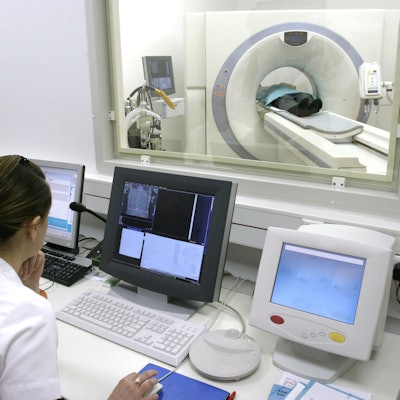
Diagnostic imaging usage rates in the U.S. have begun to decrease or stabilize in recent years for all imaging modalities with the exception of CT, for which the rate has increased in the last few years, according to an article published online December 31 in Radiology.
The group, led by Dr. Arthur Hong from the University of Texas Southwestern Medical Center, performed a retrospective analysis of utilization rates for nondiagnostic imaging exams performed in the U.S. from 2003 to 2016, including CT, MRI, nuclear imaging, ultrasound, and radiography. Their analysis covered roughly 39 million Medicare fee-for-service enrollees and approximately 10 million individuals insured by a large private health payor.
Upon examining the data, Hong and colleagues recognized a common trend in overall diagnostic imaging utilization between the Medicare and commercially insured populations: rapid growth in usage rates in the early and mid-2000s, followed by a reduction or plateauing in rates starting from the late 2000s onward.
| Trends in diagnostic imaging utilization by type of insurance | |||||||||
| Medicare | Commercial insurance (18-44 years) |
Commercial insurance (45-64 years) |
|||||||
| 2003 | 2008 | 2016 | 2003 | 2009 | 2016 | 2003 | 2008 | 2016 | |
| Imaging usage (per 1,000 enrollees) | 3,873 | 4,422 | 3,410 | 868 | 1,188 | 982 | 1,586 | 2,175 | 1,979 |
Though total imaging utilization was consistently higher in the Medicare population, the researchers found that trends in usage rates between the commercial insurance and Medicare populations were similar when considering all imaging modalities combined as well as for individual modalities.
The utilization rates for nuclear medicine and radiography were lower in 2016 than they were in 2003, regardless of the type of insurance. In the case of MRI and ultrasound, the usage rates were higher in 2016 than they were in 2003, but the year-to-year change either flatlined or slightly declined starting from the late 2000s.
This recent trend toward a decrease in annual usage rates for diagnostic imaging held true for all imaging modalities save CT, which demonstrated a sudden increase in usage rates starting from 2012 for patients ages 45 to 64 with commercial insurance and for all those with Medicare.
"It is unclear what accounts for the gradual uptick in growth of CT imaging among older adults in recent years," the authors wrote. "It is possible that hospital facilities with CT scanners are offsetting prior code bundling to maintain revenues, but why this is apparent only in CT imaging is not obvious."
The study findings may additionally shed light on the effect of radiology benefits management programs initiated by private payors, noted Drs. Keith Hentel and Michael Wolk from Weill Cornell Medicine in an accompanying editorial.
Hospitals and imaging centers are required to obtain preauthorization prior to diagnostic imaging for commercially insured patients but not for Medicare fee-for-service patients, they continued. Yet the lack of substantial differences in imaging utilization between these populations questions the efficacy of such programs in reducing usage rates.
"This lack of effect on utilization trends further suggests that cost savings realized by [private payors] through radiology benefits management are being achieved through alternate mechanisms such as steerage to lower-cost providers and cost-shifting," Hentel and Wolk wrote.
On the other hand, upcoming changes to Medicare fee-for-service policies, such as increases in payment for evaluation and management services in 2021, are likely to result in decreases in reimbursement for diagnostic imaging services as high as 9%, they concluded.




















